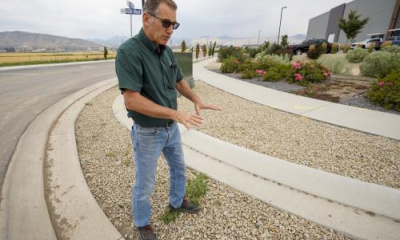Now is the time to take action to save the Great Salt Lake
SALT LAKE CITY — The Wasatch Front is on the precipice, poised to do one of two things: Cooperate and create one of the world's most important and enduring environmental triumphs, or continue along the current path and suffer the loss of everything the Great Salt Lake provides.
In North America's driest region, the Great Basin, it's no coincidence the only major metropolis sits beside an inland sea.
The Wasatch Front gets water from the Wasatch and Uinta mountains, but we now know the lake plays a vital role in that process. It turbocharges as many as 13 snow storms in the average year, with its water holding warmth and sending energy into the colder air.
The lake also caps dangerous dust that would otherwise blow into the lungs of residents and visitors; dust made worse by chemicals being sent downstream.
We know the lake is a critical habitat for many species of birds.
And we know the Great Salt Lake is sick, but it's not dead.
"The good news for the Great Salt Lake is you still have a lake," said Phil Kiddoo with the Great Basin Unified Air Pollution Control District.
However, that's not the case in the Owens Valley in California where Kiddoo monitors efforts to tamp down the worst site of airborne dust in the country. Owens Lake dried up a century ago, victim to the thirst of Los Angeles.
The lesson learned from Owens Lake is that a dry lakebed is a disaster for people and the environment.
"There was a time when all the dust gathered and went into the aqueduct. We had a huge deluge of water and it came out and flooded the whole area and the dust became almost like cement, and it was this deep and it really killed all the plants and everything in it's way," explained Chris Langley.
Owens Lake also showed that mitigation is expensive, time consuming and ongoing.
"It's something that has to be perpetually maintained and operated," shared Kiddoo.
So far, $2.5 billion has been spent at Owens Lake, which is tiny compared to the Great Salt Lake. Farmington Bay alone, now largely dry, is about the same size as Owens Lake when it was full.
But drive north from Owens to Mono lake and a much better scenario can be found.
When Los Angeles started taking water from two creeks that fill Mono Lake, the lake went down and the streams dried up. For more than three decades, locals got nowhere protesting the harm to their lake.
"They went to the decision makers and said this is going to be a problem. And the answer was, there's really nothing we can do about that, that's how water rights work," said Geoff McQuilkin with the Mono Lake Committee.
That changed when activists, academics and college students studied Mono Lake, formed the Mono Lake Committee in 1978 and partnered with the Audubon Society to sue on behalf of the lake itself. The lawsuit was won in California's Supreme Court, forcing Los Angeles to keep the creeks flowing at a certain level before diverting any water.
These days, Mono Lake is smaller than it was, but it is surviving.
From the near disaster in California, it was learned that a ruinous trajectory can be halted and potentially reversed, environmental laws with real teeth can work and structured agreements can lead to healthy and successful collaboration
But Utah's problem exists on a different scale. Even now, the Great Salt Lake is about 14 times bigger than Mono Lake, with nearly 2.5 million people living next door. Those are the facts that make the problem bigger and the need for action more urgent.
Among the advantages of the Wasatch Front are that the lake that can still be saved, and examples are available showing how it might be done.
The biggest hope springs from necessity. Fighting for the lake is fighting for the health of Utahns and the health of the home they love.








